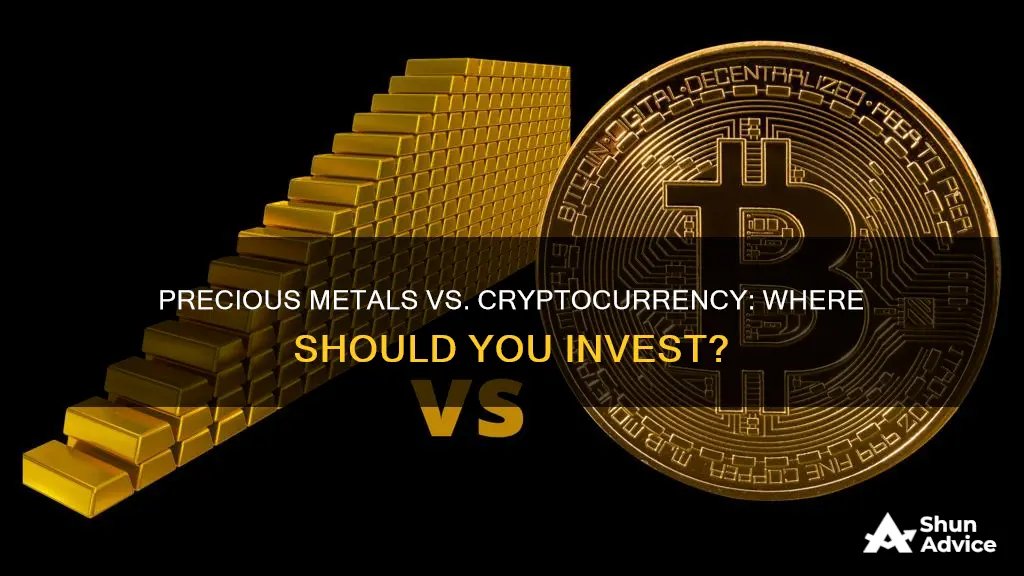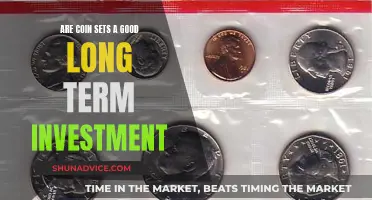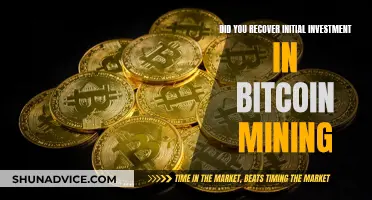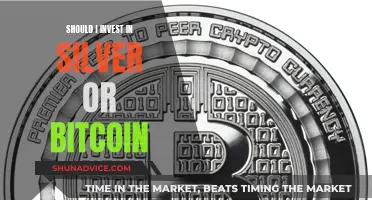
Investing in precious metals or cryptocurrency is a hotly debated topic. Precious metals like gold, silver, and platinum have traditionally been seen as a store of value and a hedge against inflation. They are tangible assets that hold their value well due to their scarcity and industrial uses. On the other hand, cryptocurrencies are volatile and subject to market forces, but they offer increased accessibility and fractional ownership. So, which is the better investment?
| Characteristics | Values |
|---|---|
| Initial Investment | Precious metals require a large initial investment, whereas cryptocurrencies can be bought in smaller amounts. |
| Volatility | Precious metals are less volatile than cryptocurrencies. |
| Liquidity | Precious metals are more liquid than cryptocurrencies. |
| Accessibility | Cryptocurrencies are more accessible and easier to purchase than precious metals. |
| Tangibility | Precious metals are tangible assets, whereas cryptocurrencies are digital. |
| Scarcity | Both precious metals and cryptocurrencies have built-in scarcity. |
| Industrial Use | Precious metals have a range of industrial uses, while cryptocurrencies are primarily used for transactions and speculation. |
What You'll Learn

Precious metals' value against inflation
Precious Metals Value Against Inflation
Precious metals like gold, silver, platinum, and palladium are valuable because of their scarcity and industrial applications. They are a good hedge against inflation due to their stable value and limited supply. Inflation erodes the value of paper currency, but precious metals can protect your wealth.
Gold is the most well-known precious metal and has been a store of value for centuries. It has unique properties, such as durability and conductivity, and is used in jewellery, electronics, and dentistry. The price of gold is influenced by market supply, interest rates, and investor sentiment about inflation.
Silver is the second most common precious metal and is vital for solar panels and other electrical applications. Its price is more volatile than gold due to its dual role as an industrial metal and a store of value.
Platinum is essential for catalytic converters in vehicles and has some investment value due to its rarity. Palladium, another rare metal, is used in electronics, medicine, and groundwater treatment, but its high price makes it less accessible to beginning investors.
Precious metals prices tend to rise with or above inflation, making them a good investment during economic uncertainty. They are a tangible, liquid asset, providing portfolio diversification. However, there are costs associated with storing and insuring physical metals, and they don't generate income.
Cryptocurrencies pose an emerging risk to precious metals investing as they offer similar investment properties. However, precious metals have a long history as a stable investment, and their value is expected to remain stable due to their limited supply and industrial uses.
Coinbase Investment Opportunities: Exploring Your Options
You may want to see also

Initial investment costs
One of the biggest barriers to investing in precious metals is the initial cost. Precious metals are valuable because they are scarce, useful for industrial processes, and have properties that make them a good store of value. As a result, they tend to be expensive, even at the outset. This creates a high barrier to entry that other investment options may not have. For example, gold is the most well-known and investable precious metal, but it can be costly to purchase, especially in the form of bars or coins.
However, it is important to note that investors do not need to buy large pieces if they cannot afford them. Gold ingots, for instance, are a more budget-friendly option. Additionally, silver is a more affordable precious metal that still offers investment potential.
For those looking for even smaller investments, tokenized precious metals provide an innovative approach. Tokenization allows for the division of a single unit of a precious metal into smaller, more affordable fractions. This democratization of access enables a wider range of investors to participate in the precious metals market, regardless of their budget. For example, investors can now purchase as little as $500 worth of tokenized precious metals.
In contrast, cryptocurrencies can be purchased in small amounts, with no minimum investment required. This makes it easier for beginners to enter the market without a large amount of capital.
When considering initial investment costs, it is worth noting that precious metals and cryptocurrencies differ in how they are traded. Precious metals are typically bought and sold through dealers or brokers, while cryptocurrencies are traded on exchanges. The transaction costs associated with each can vary, impacting the overall affordability of the investment.
Overall, while precious metals may have higher initial investment costs, there are options available to suit different budgets. Tokenized precious metals, in particular, offer a more accessible way to invest in this asset class.
Bitcoin Gold: A Smart Investment Move?
You may want to see also

Built-in scarcity
Scarcity is a key factor in the value of both cryptocurrencies and precious metals. In the case of cryptocurrencies, the argument for their value often revolves around their built-in scarcity. For instance, Bitcoin has a fixed supply cap of 21 million coins. This scarcity is enforced through its proof-of-work consensus mechanism, where miners compete to solve complex cryptographic puzzles to validate transactions and create new blocks on the blockchain. The difficulty of this process and the finite number of Bitcoins that can be mined contribute to its scarcity.
On the other hand, precious metals like gold, silver, and platinum are also considered scarce resources. Their value stems from their rarity in the Earth's crust and the significant costs and challenges associated with mining and extracting them. The process of obtaining these metals involves exploration, mining, refining, and purification, all of which are time-consuming and resource-intensive.
The concept of "digital scarcity" in cryptocurrencies like Bitcoin is analogous to the natural scarcity of precious metals. Both types of assets have limited availability, which, in the eyes of investors, can make them attractive stores of value and potential hedges against inflation.
However, it is worth noting that the perception of scarcity can be influenced by various factors. For instance, in the case of precious metals, the discovery of new sources of ore or advancements in mining and refining technologies may lead to an increased supply, thereby reducing their scarcity and potentially impacting their value. Similarly, in the cryptocurrency space, the emergence of new coins with different scarcity models or the creation of additional units of existing coins through events like "forking" can affect the overall perception of scarcity.
In summary, both cryptocurrencies and precious metals possess built-in scarcity that contributes to their value. However, it is important to recognize that the degree of scarcity and its impact on value can fluctuate due to various economic, technological, and geological factors.
Minecoin Investment: Worthwhile or Risky Venture?
You may want to see also

Capital gains taxes
When deciding whether to invest in precious metals or cryptocurrency, it is important to consider the tax implications of both options. Both types of investments are subject to capital gains taxes, but the specific rules and rates vary.
The Internal Revenue Service (IRS) in the United States treats precious metals such as gold, silver, platinum, and palladium as capital assets, which are subject to capital gains tax. The tax rate depends on the holding period of the metal. If the metal is held for less than a year, any profits are taxed as ordinary income. If the metal is held for more than a year, the profits are subject to a 28% capital gains tax rate. The IRS considers precious metals to be collectibles, which are taxed at a higher rate than other capital assets. Additionally, some states in the US exempt precious metals from sales tax, while others levy a sales tax ranging from 0% to 10%.
Cryptocurrency is also subject to capital gains tax in the US. If you sell, trade, or spend cryptocurrency for a profit, you will owe capital gains tax on that profit. The tax rate depends on the holding period of the cryptocurrency and your income level. If you hold the crypto for less than a year before selling, you will pay a short-term capital gains tax rate, which is the same as your income tax rate. If you hold the crypto for more than a year, you will pay a long-term capital gains tax rate of 0%, 15%, or 20%, depending on your income. It is important to note that the IRS treats cryptocurrency as property for tax purposes, and there are specific rules for calculating the cost basis of the crypto assets. Additionally, there are other transactions related to cryptocurrency that may be taxed as income, such as mining, staking, and receiving crypto as payment.
In summary, both precious metals and cryptocurrency investments are subject to capital gains taxes, but the specific rules and rates differ. Precious metals are taxed at a higher rate than other capital assets, while the tax rate for cryptocurrency depends on the holding period and income level. It is important to carefully consider the tax implications when deciding whether to invest in precious metals or cryptocurrency.
Bitcoin Investment: Is It Trustworthy?
You may want to see also

Volatility-resistant assets
Volatility refers to the degree of variation in the price of a traded asset over a given period. It is often associated with large price swings in either direction. An asset with high volatility means that its value can be spread out over a large range of values, indicating that its price can change dramatically over a short period.
Precious Metals
Precious metals, such as gold, silver, platinum, and palladium, have historically been considered volatility-resistant assets due to their scarcity and industrial uses. They tend to hold their value well over time, making them attractive stores of value during economic uncertainty.
Gold, for example, is known for its durability, shaping capability, and ability to conduct heat and electricity. It is also sought after in jewellery and as a form of currency. Silver, on the other hand, is widely used in electrical, electronic, and photography industries. Platinum and palladium also have important industrial applications.
However, it is important to note that the prices of precious metals can still experience volatility due to various factors, including changes in the economy, investor demand, mining supply, and inflation. Additionally, the costs associated with storing and insuring physical precious metals can be a disadvantage for investors.
Cryptocurrencies
Cryptocurrencies, on the other hand, are known for their high volatility. They have experienced significant price swings, with values fluctuating dramatically over short periods. This volatility is driven by various factors, including news, regulatory changes, and market sentiment.
However, it is worth noting that the volatility in cryptocurrencies can create opportunities for traders and investors. The decentralized nature of cryptocurrencies also makes them attractive to those seeking an alternative to traditional financial systems.
Comparison
When comparing precious metals and cryptocurrencies in terms of volatility resistance, precious metals generally exhibit lower volatility due to their tangible nature and historical use as stores of value. Cryptocurrencies, being a newer asset class, tend to be more volatile and subject to higher price fluctuations.
However, it is essential to consider other factors when making investment decisions, such as liquidity, diversification, and individual risk appetite. Both precious metals and cryptocurrencies can have a place in a well-diversified portfolio, depending on an investor's goals and preferences.
In conclusion, while precious metals may be considered more volatility-resistant compared to cryptocurrencies, it is crucial to acknowledge that all investments carry some level of risk, and conducting thorough research before investing is always advisable.
Best Crypto Coins: Where to Invest Your Money?
You may want to see also
Frequently asked questions
Precious metals tend to hold their value well over time and act as a hedge against inflation. They are also tangible assets that are relatively easy to purchase and provide portfolio diversification.
Investing in precious metals typically requires a large initial investment, and when you sell, you may be subject to high capital gains taxes. Additionally, there are costs associated with storing and insuring physical metals, and they do not generate income.
Cryptocurrency offers high accessibility and fractional ownership, allowing investors with varying budgets to participate in the market. It also provides 24/7 access to global liquidity and can serve as a hedge against inflation.
Cryptocurrency is highly volatile and subject to significant price fluctuations. It is also a relatively new and evolving market, with regulatory uncertainty and technological vulnerabilities that may pose risks to investors.







